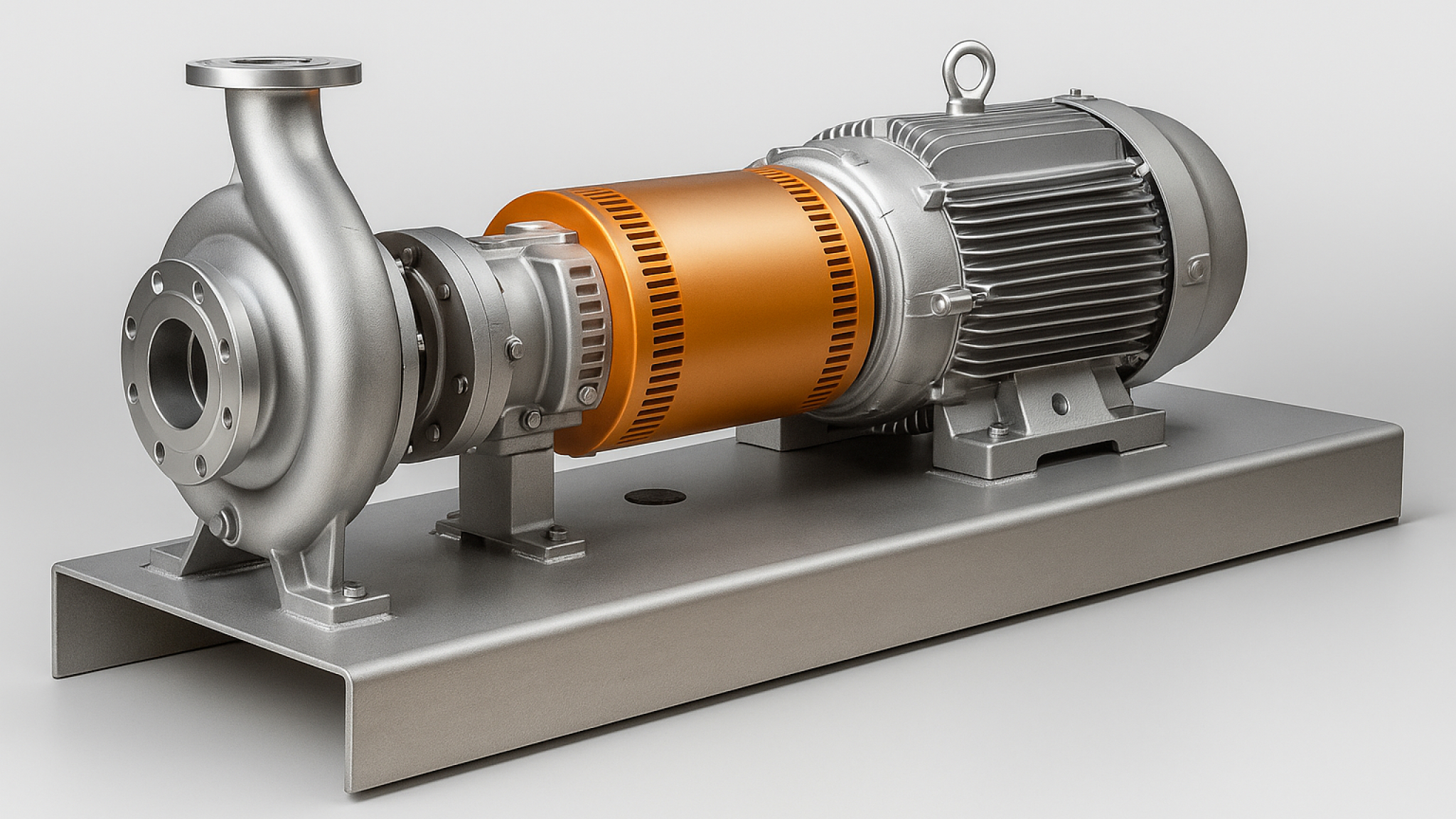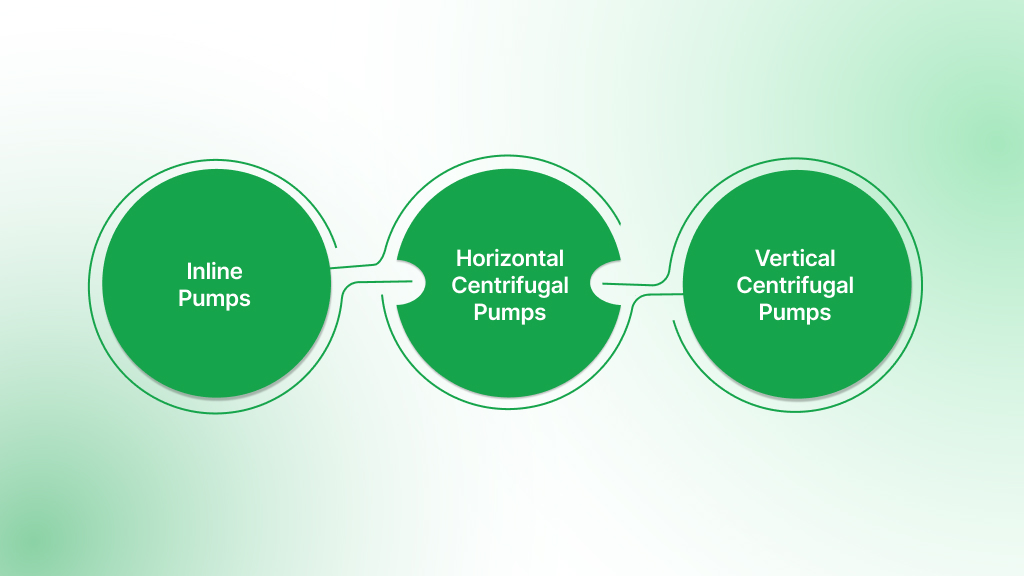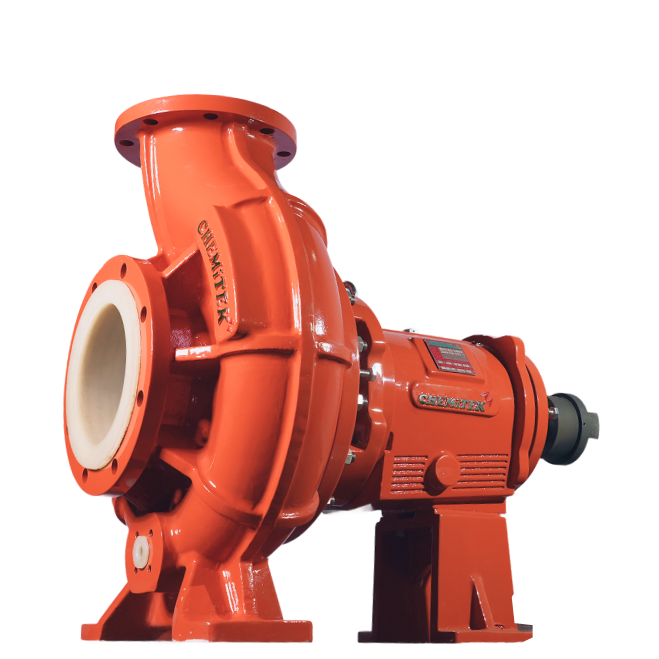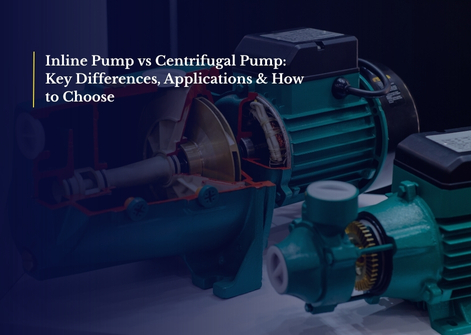Pump orientation and configuration are not just engineering specs; they can make or break overall efficiency, maintenance cost, and system reliability. In many plants, space constraints, piping layouts, or suction conditions force a choice between inline, horizontal, or vertical centrifugal designs, each with its own trade‑offs.
Engineers need more than just a catalog‑spec pump; they need to know how those differences impact performance under their real operating conditions.
In this article, we’ll examine the distinctions between inline and horizontal/vertical centrifugal pumps, where each design excels, what to watch out for, and how to decide based on your process needs.
By the end, you’ll be better equipped to choose the pump layout that matches your fluid, space, maintenance, and cost constraints.
Key Takeaways
Inline, horizontal, and vertical centrifugal pumps each serve specific system needs; what works in a compact HVAC setup may not suit a process-critical chemical line. This guide outlined:
• How each pump type impacts layout, flow efficiency, and maintenance
• Situations where one configuration clearly outperforms the others
• Chemitek’s strength in delivering horizontal pumps built for harsh, high-demand applications
Choosing the right configuration is about matching pump geometry with operational realities, not just design specs.
Understanding Inline and Centrifugal Pumps
Before we dive into specific configurations like horizontal, vertical, or inline, it’s important to clarify what a centrifugal pump is and how “inline” fits into this category. While all these designs operate on the same core principle, their layout and application impact vary significantly.
What is a Centrifugal Pump?
Centrifugal pumps use rotational energy from an impeller to move fluids. As the impeller spins, fluid is drawn into the center and flung outward by centrifugal force. This movement converts kinetic energy into pressure, enabling the fluid to flow through a piping system.
These pumps are ideal for continuous-flow applications and are widely used in water supply, chemical transfer, and HVAC systems. All centrifugal pumps share this operating principle, but the orientation and mounting of the pump can influence performance, efficiency, and maintenance requirements.
What is an Inline Pump?
An inline pump is a type of centrifugal pump where the inlet and outlet are aligned, typically in a straight line, allowing the fluid to enter and exit without changing direction. This design makes inline pumps compact and easy to install within a pipeline, especially in tight spaces.
Inline pumps are often used in commercial HVAC, water circulation, and chemical transfer systems where space efficiency and ease of pipe routing are critical. While they operate using the same impeller-driven mechanism as other centrifugal pumps, their form factor introduces unique advantages and trade-offs.
Let's look at it in more depth.
Inline Pumps: Design and Use Cases
Inline pumps are defined by their straight-through configuration and vertically oriented design, but their real-world value lies in how that geometry translates to performance. Below are the physical construction traits and the typical environments where inline pumps thrive.
Design Characteristics

- Straight-line flow path: Reduces turbulence and simplifies pipe layout.
- Close-coupled build: Motor is directly mounted above the impeller, saving space and reducing alignment issues.
- Compact vertical profile: Fits easily into mechanical rooms, skids, or retrofitted systems with space limitations.
Where Inline Pumps Excel
- HVAC Systems: Perfect for chilled and hot water circulation where space and access are tight.
- Booster Systems: Used in municipal and industrial water systems for compact pressure boosting.
- Chemical Transfer: Effective for small-scale or moderately corrosive applications where simple, space-saving pumps are needed.
- Fire Protection Loops: Straight-through configuration makes integration into fire suppression systems efficient and clean.
Inline pumps shine in low- to mid-pressure applications where space efficiency and maintenance simplicity are critical priorities.
How Conventional Centrifugal Pumps Work
Before comparing centrifugal and inline configurations directly, it’s important to understand how a standard centrifugal pump operates. These pumps rely on dynamic action, converting mechanical energy from a rotating impeller into kinetic energy and then pressure to move fluid through a system.
Impeller-Driven Flow
At the heart of a centrifugal pump is the impeller. As it spins, it draws fluid into the center (eye) and accelerates it outward along the vanes. The velocity imparted to the fluid is then converted into pressure as it exits through the pump casing.
This continuous, non-pulsating flow is ideal for systems requiring stable delivery over time.
Casing Design and Pressure Generation
The casing (usually volute or diffuser-type) slows down the high-velocity fluid and builds pressure before discharging it into the pipeline. The geometry of the casing plays a key role in:
- Energy conversion efficiency
- Radial load balancing
- Noise and vibration control
Shaft, Bearings, and Seal Systems
Centrifugal pumps also include:
- Shaft: Connects impeller to motor
- Bearings: Absorb radial and axial loads
- Seals or packing: Prevent leakage at the shaft entry point
Each of these components must be engineered for the specific process environment, taking into account factors such as fluid type, temperature, pressure, and chemical aggressiveness.
Horizontal & Vertical Centrifugal Pumps: Advantages & Challenges

Centrifugal pumps are broadly classified by shaft orientation: horizontal or vertical. While both share the same hydraulic principle, their installation, maintenance, and application characteristics differ and can impact performance and plant design.
Horizontal Centrifugal Pumps
Horizontal pumps have the shaft mounted parallel to the ground and are the most widely used design in industrial settings.
Advantages:
- Easier to inspect, maintain, and replace parts like bearings or seals
- Can handle higher NPSH requirements due to proximity to the suction source
- Supports larger impellers and motors in base-mounted designs
Limitations:
- Requires more floor space
- May need alignment during installation and after maintenance
- Not ideal where the flooding risk is high
Vertical Centrifugal Pumps
In vertical designs, the motor is mounted above the pump, and the shaft extends downward into the process fluid or piping.
Advantages:
- Saves floor space, ideal for tight installations
- Often self-venting; better suited for flooded suction or sump applications
- Easier to isolate motors from fluid contact in corrosive environments
Limitations:
- Maintenance can be more difficult, especially for deep-set designs
- Limited impeller size options compared to horizontal variants
- Requires more precise alignment during installation
While all three layouts, inline, horizontal, and vertical, fall under the centrifugal pump category, selecting the right one depends heavily on system layout, fluid properties, and accessibility for maintenance.
That’s where application-specific engineering becomes critical, ensuring that the chosen configuration aligns with performance, safety, and long-term reliability goals. Let’s stack them side by side.
Key Comparison Table: Inline vs Horizontal vs Vertical Centrifugal Pumps
To simplify the selection process, the following table summarizes the core differences between inline, horizontal, and vertical centrifugal pumps across critical engineering and operational parameters:
This table simplifies the trade-offs, making it easier to align your pump configuration with actual project conditions. Next, we look at where each design thrives in real-world applications.
Common Applications by Pump Type
Each centrifugal pump configuration serves specific roles based on its mechanical design, space requirements, and fluid handling capabilities. Below is an overview of where inline, horizontal, and vertical centrifugal pumps are most commonly used in industrial and commercial systems.

Inline Pumps
Inline pumps excel in environments where space is limited and streamlined piping is a priority.
Typical Applications:
- HVAC Systems: Chilled and hot water circulation in commercial buildings
- Booster Systems: Municipal and industrial water pressure boosting
- Chemical Transfer: Compact setups for corrosive or light-duty chemical movement
- Fire Suppression Systems: In-line designs ensure easy integration into sprinkler loops
Horizontal Centrifugal Pumps
The most versatile and widely used pump type in industrial fluid handling.
Typical Applications:
- Chemical Processing: For clean, mildly corrosive, or abrasive fluids
- Water and Wastewater: Reliable service in treatment plants and filtration systems
- Cooling Systems: Circulation in power generation, refineries, and HVAC
- Food and Pharma: When designed with hygienic materials and seals
Vertical Centrifugal Pumps
Vertical configurations are used where floor space is restricted or where the pump needs to be submerged or operate with flooded suction.
Typical Applications:
- Sump Pumping: Removing water or chemicals from tanks or sumps
- Flood Control: Where deep-well or vertical lift is required
- Chemical Storage Drainage: Keeping motors out of direct chemical exposure
- Industrial Cooling Towers: Circulating large volumes in vertical layouts
While applications guide initial selection, performance and reliability determine long-term success. The best pump for the job isn’t just the one that fits the system layout; it’s the one that consistently delivers under load, resists wear, and minimizes downtime.
In the next section, we’ll examine how inline, horizontal, and vertical centrifugal pumps compare when it comes to real-world operation and maintenance.
Performance & Maintenance Considerations
Beyond installation and application fit, the operational behavior of a pump can make or break system reliability. From flow stability and energy consumption to ease of maintenance and component wear, each configuration brings its own strengths and trade-offs.
Flow Stability and Efficiency
- Inline Pumps generally offer consistent performance for moderate flow and head ranges but may see reduced efficiency if oversized or misaligned with system demand. Their straight-through flow path minimizes turbulence, resulting in stable, non-pulsating flow delivery.
- Horizontal Centrifugal Pumps are known for higher efficiency across a broader range of flow rates. When sized near their Best Efficiency Point (BEP), they deliver optimal energy performance and longevity.
- Vertical Pumps can deliver excellent efficiency in flooded suction or sump applications, but may struggle with fluctuating suction conditions or air entrainment.
Vibration, Wear, and Operating Stress
- Inline designs can be more sensitive to piping-induced stress and vibration due to their integrated, close-coupled build.
- Horizontal models benefit from base-mounted rigidity and better vibration damping, making them well-suited for heavy-duty applications.
- Vertical setups require precise shaft alignment to prevent vibration and premature wear, especially in tall or submerged configurations.
Maintenance and Servicing
- Inline Pumps are compact but may require lifting or disassembling piping for internal access, unless designed with cartridge-style servicing.
- Horizontal Pumps are the most service-friendly seals, bearings, and impellers are easily accessible without disturbing pipework.
- Vertical Pumps can be more challenging to service, particularly if installed in deep-well or below-grade applications. Accessing seals or impellers may involve disassembly or lifting equipment.
Downtime Risk and Spare Part Management
- Horizontal pumps typically allow quicker seal and bearing replacements, reducing downtime.
- Inline and vertical pumps may need more planning and parts access, especially in systems with tight access or overhead installations.
- Maintenance access should always be matched to the operational criticality of the pump, especially in 24/7 plants where unplanned shutdowns carry a high cost.
Choosing the Right Pump: Key Decision Factors
Selecting between inline, horizontal, or vertical centrifugal pumps is about balancing space constraints, fluid characteristics, reliability needs, and serviceability within your plant’s operational reality. Here are the key considerations:
1. System Layout and Piping Constraints
- If your setup involves retrofitting or tight mechanical spaces, inline pumps offer a compact, in-line solution that minimizes piping reroutes and installation time.
- Horizontal pumps require more floor space but offer flexible piping and easier baseplate integration.
- Vertical pumps are best suited where floor space is at a premium or the pump needs to sit directly in a tank or sump.
2. Fluid Characteristics
- When handling aggressive, abrasive, or high-temperature fluids, selecting compatible materials is critical. Horizontal pumps typically offer more customization with non-metallic or corrosion-resistant options.
- Inline designs may have fewer material options, making them more suitable for clean or mildly corrosive duties.
3. Maintenance Strategy
- If downtime is costly, horizontal pumps are ideal they allow fast access to seals, bearings, and impellers without removing pipework.
- Inline and vertical pumps often require more disassembly or lifting equipment, which can increase service time and complexity.
4. Pressure and Flow Requirements
- Horizontal pumps support higher pressure and flow ranges and maintain efficiency across a broad performance curve.
- Inline and vertical pumps work well for moderate pressures and flow rates, especially when space limitations take precedence.
5. Chemitek’s Engineering Advantage
Chemitek specializes in horizontal centrifugal pump systems engineered for the realities of aggressive fluid handling. From high-efficiency impellers to non-metallic, corrosion-resistant builds, every pump is designed to fit seamlessly into your process with fewer maintenance demands and longer service intervals. Chemitek’s modular approach ensures your system isn’t just operational, but optimized.
To sum up, there’s no one-size-fits-all answer. Your system’s performance depends on choosing the pump layout that integrates seamlessly with your process, not just on paper, but in actual plant conditions.
Connect with our team to discuss your application and to understand how engineered pump configurations, matched by material compatibility, hydraulic performance, and serviceability, can optimize uptime, efficiency, and lifecycle cost.
Conclusion: Fit the Pump to the Process
Pump selection is less about preference and more about harmonizing your equipment with operational realities. Inline designs are well-suited for compact, fixed-flow systems. Horizontal centrifugal pumps, on the other hand, provide the robustness and flexibility needed for high-demand, service-critical environments.
To get lasting value from your pump system, match its configuration to the physical constraints, maintenance expectations, and fluid challenges of your facility. When your needs involve corrosive media, variable flows, or long service intervals, engineered systems like Chemitek’s horizontal pump assemblies offer the performance edge to keep operations smooth and predictable.
FAQs
1. Are inline pumps a type of centrifugal pump?
Yes, inline pumps are a subset of centrifugal pumps. They use the same impeller-based mechanism to move fluids, but differ in layout, featuring a straight-through, space-saving design where inlet and outlet ports are aligned.
2. When should I choose an inline pump over a horizontal centrifugal pump?
Choose inline pumps when space is limited, and your system requires simplified piping or a minimal floor footprint, like in HVAC systems or building retrofits. However, for higher flows or easier maintenance, horizontal pumps may be better.
3. What is the main limitation of vertical centrifugal pumps?
Vertical pumps can be harder to service, especially if installed in deep wells or below-grade tanks. Accessing the shaft, seals, or impeller often requires disassembly or lifting equipment.
4. Does Chemitek offer inline or vertical centrifugal pumps?
Chemitek specializes in horizontal centrifugal pumps, offering modular, corrosion-resistant systems tailored to industrial fluid handling. While they don’t currently offer inline or vertical models, their horizontal designs are engineered to deliver maximum uptime and ease of service.

Latest posts

Difference Between Inline Pump and Centrifugal Pump
Ready to Upgrade Your Process Operations?